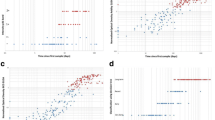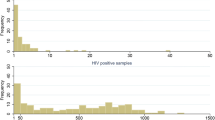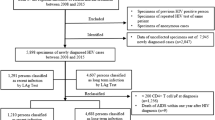Abstract
The suitability of routine diagnostic HIV assays to accurately discriminate between recent and non-recent HIV infections has not been fully investigated. The aim of this study was to compare an established HIV recency assay, the Sedia limiting antigen HIV avidity assay (LAg), with the diagnostic assays; Abbott ARCHITECT HIV Ag/Ab Combo and INNO-LIA HIV line assays. Samples from all new HIV diagnoses in Ireland from January to December 2016 (n = 455) were tested. An extended logistic regression model, the Spiegelhalter–Knill–Jones method, was utilised to establish a scoring system to predict recency of HIV infection. As proof of concept, 50 well-characterised samples were obtained from the CEPHIA repository whose stage of infection was blinded to the authors, which were tested and analysed. The proportion of samples that were determined as recent was 18.1% for LAg, 6.4% with the ARCHITECT, and 14.5% in the INNO-LIA assay. There was a significant correlation between the ARCHITECT S/CO values and the LAg results, r = 0.717, p < 0.001. ROC analysis revealed that an ARCHITECT S/CO < 250 had a sensitivity and specificity of 90.32% and 89.83%, respectively. Combining the Abbott ARCHITECT HIV Ag/Ab Combo assay and INNO-LIA HIV assays resulted in an observed risk of being recent of 100%. Analysis of the CEPHIA samples revealed a strong agreement between the LAg assay and the combination of routine assays (κ = 0.908, p < 0.001). Our findings provide evidence that assays routinely employed to diagnose and confirm HIV infection may be utilised to determine the recency of HIV infection.



Similar content being viewed by others
References
Moyo S, Wilkinson E, Novitsky V et al (2015) Identifying recent HIV infections: from serological assays to genomics. Viruses 7(10):5508–5524. https://doi.org/10.3390/v7102887
Schüpbach J, Gebhardt MD, Tomasik Z et al (2007) Assessment of recent HIV-1 infection by a line immunoassay for HIV-1/2 confirmation. PLoS Med 4(12):e343
Schüpbach J, Gebhardt MD, Scherrer AU et al (2013) Simple estimation of incident HIV infection rates in notification cohorts based on window periods of algorithms for evaluation of line-immunoassay result patterns. PLoS One 8(8):e71662. https://doi.org/10.1371/journal.pone.0071662
Schupbach J, Bisset LR, Regenass S et al (2011) High specificity of line-immunoassay based algorithms for recent HIV-1 infection independent of viral subtype and stage of disease. BMC Infect Dis 11:254
Schupbach J, Bisset LR, Gebhardt MD et al (2012) Diagnostic performance of line-immunoassay based algorithms for incident HIV-1 infection. BMC Infect Dis 12:88
Schüpbach J, Niederhauser C, Yerly S et al (2015) Decreasing proportion of recent infections among newly diagnosed HIV-1 cases in Switzerland, 2008 to 2013 based on line-immunoassay-based algorithms. PLoS One 10(7):e0131828. https://doi.org/10.1371/journal.pone.0131828
Wei X, Liu X, Dobbs T, Kuehl et al (2010) Development of two avidity-based assays to detect recent HIV type 1 seroconversion using a multisubtype gp41 recombinant protein. AIDS Res Hum Retrovirus 26:1–11
Duong YT, Qiu M, De AK et al (2012) Detection of recent HIV-1 infection using a new limiting-antigen avidity assay: potential for HIV-1 incidence estimates and avidity maturation studies. PLoS One 7:e33328
Parekh B, Duong Y, Mavengere Y et al (2012) Performance of new LAg-Avidity EIA to measure HIV-1 incidence in a cross-sectional population: Swaziland HIV Incidence Measurement Survey (SHIMS). In: XIX international AIDS conference. Washington DC. July 22–27, Abstract #LBPE27
Schwarcz S, Kellogg T, McFarland W et al (2001) Differences in the temporal trends of HIV seroincidence and seroprevalence among sexually transmitted disease clinic patients, 1989–1998: application of the serological testing algorithm for recent HIV seroconversion. Am J Epidemiol 153:925–934
Machado DM, Delwart EL, Diza RS et al (2002) Use of the sensitive/less-sensitive (detuned) EIA strategy for targeting genetic analysis of HIV-1 recently infected blood donors. AIDS 16:113–119
Duong YT, Kassanjee R, Welte A et al (2015) Recalibration of the limiting antigen avidity EIA to determine mean duration of recent infection in divergent HIV-1 subtypes. PLoS One 10(2):e0114947. https://doi.org/10.1371/journal.pone.0114947
Seymour DG, Green M, Vaz FG (1990) Making better decisions: construction of clinical scoring systems by the Spiegelhalter–Knill–Jones approach. BMJ 300:223–226
Chan SF, Deeks JJ, Macaskill P, Irwig L (2008) Three methods to construct predictive models using logistic regression and likelihood ratios to facilitate adjustment for pretest probability give similar results. J Clin Epidemiol 1:52–63
Suligoi B, Rodella A, Raimondo M et al (2011) Avidity index for anti-HIV antibodies: comparison between third- and fourth-generation automated immunoassays. J Clin Micro 49:2610–2613
Glese C, Igoe D, Gibbons Z, Hurley C, Stokes S, McNamara S, Ennis O, O’Donnell K, Keenan E, De Gascun C, Lyons F, Ward M, Danis K, Glynn R, Waters A, Fitzgerald M, On behalf of the outbreak control team (2015). Injection of new psychoactive substance snow blow associated with recently acquired HIV infections among homeless people who inject drugs in Dublin, Ireland. Eurosurveillance 20(40):30036
Keating SM, Pilcher CD, Jain V et al (2017) HIV antibody level as a marker of HIV persistence and low level viral replication. J Infect Dis 216:72–81
Wendel SK, Longosz AF, Eshleman SH et al (2017) Short communication: the impact of viral suppression and viral breakthrough on limited-antigen avidity assay results in individuals with clade B HIV infection. AIDS Res Hum Retrovirus 33(4):325–327. https://doi.org/10.1089/AID.2016.0105
Manns A, Miley WJ, Wilks RJ et al (1999) Quantitative proviral DNA and antibody levels in the natural history of HTLV-I infection. J Infect Dis 180(5):1487–1493
Grebe E, Welte A, Hall J et al (2017) Infection staging and incidence surveillance applications of high dynamic range diagnostic immune-assay platforms. J Acquir Immune Defic Syndromes 76(5):547–555
Author information
Authors and Affiliations
Contributions
Concept and design of the study: JH and JM; acquisition of data: JH and JM, statistical analysis: JH and OM; interpretation of data and drafting the manuscript: JH and JC; critical revision of the manuscript: CDG and GM.
Corresponding author
Ethics declarations
Conflict of interest
The authors declare they have no conflict of interest.
Ethical approval
For this type of study, formal consent is not required.
Additional information
Edited by: Oliver T Keppler.
Publisher’s Note
Springer Nature remains neutral with regard to jurisdictional claims in published maps and institutional affiliations.
Appendix
Appendix
A summary of the statistical techniques used to derive Spiegelhalter–Knill–Jones weightings is outlined by Seymour et al. [13].
To employ the Spiegelhalter–Knill–Jones method, which is an extension of logistic regression, all explanatory variables as well as the outcome variable must be binary. The LAg assay is the outcome variable and a cut-off of ODn ≤ 1.5 is used, with those ≤ 1.5 regarded as being recent infections. Algorithm 15.1 is presented in the data set as a binary variable (recent or non-recent), so no division or recoding is needed. A cut-off for the ARCHITECT S/CO of 250 was used in this study, with values < 250 regarded as recent infections.
Briefly as outlined by Seymour et al. [13], the mathematical derivation of Spiegelhalter–Knill–Jones weightings:
-
The independence Bayes’ equation is:
where
-
(a)
the posterior odds are the predicted odds of the outcome in an individual;
-
(b)
the prior odds are the odds of the outcome in the population under study;
-
(c)
LR is the likelihood ratio:
-
Taking the natural logarithms and multiplying by 100, the independence Bayes’ equation becomes the following:
-
In terms of the Spiegelhalter–Knill–Jones method, this equation becomes the following:
-
This equation assumes that the variables are independent of one another, which is unrealistic in many cases, so the Spiegelhalter–Knill–Jones method calculates adjusted weights to account for dependence. Adjusted weights are obtained by entering the raw weights of evidence as independent variables in a logistic regression equation. This produces the final form of the predictive equation:
-
Because T = 100 × ln(posterior odds) and because odds = probability/(1 − probability), the predicted probability can be calculated by the following:
Therefore, Ln(p/1 − p) = T/100:
The application of the Spiegelhalter–Knill–Jones method for the two variables studied (Algorithm 15.1 and ARCHITECT S/CO) is shown below (Table 3).
LR and Crude weights were calculated as shown below. Logistic coefficients were obtained by logistic regression analysis of the raw data using SPSS 22.
Individual markers
ARCHITECT S/CO versus LAg as the gold standard
Sensitivity = 21/30 = 70%.
Specificity = 112/118 = 94.9%.
The observed risk of being recent when ARCHITECT < 250 (suggests recency) is 21/27 = 77.8% (as shown in Table 2 in the manuscript).
Likelihood ratios for recency:
Sensitivity/100 − Specificity = 70.0/100 − 94.9 = 70.0/5.1 = 13.73.
Ln13.73 = 2.62.
2.62 × 100 = 262 = weighting to be applied to a recent test.
Likelihood ratios for non- recency:
100 − Sensitivity/Specificity = 100 − 70.0/94.9 = 30.0/94.9 = 0.316.
Ln0.316 = − 1.152.
− 1.152 × 100 = − 115.2 = weighting to be applied to a non-recent test.
Algorithm 15.1 versus LAg as the gold standard
Sensitivity = 39/76 = 51.3%.
Specificity = 323/345 = 93.6%.
The observed risk of being recent when Algorithm 15.1 suggests that recency is 39/61 = 63.9% (as shown in Table 2 in the manuscript).
Likelihood ratios for recency:
Sensitivity/100 − Specificity = 51.3/100 − 93.6 = 51.3/6.4 = 8.016.
Ln8.016= 2.081.
2.081 × 100 = 208 = weighting to be applied to a recent test.
Likelihood ratios for non-recency:
100 − sensitivity/specificity = 100 − 51.3/93.6 = 48.7/93.6 = 0.520.
Ln0.520= − 0.654.
− 0.654 × 100 = − 65.4 = weighting to be applied to a non-recent test.
Predictive analysis for the two markers—ARCHITECT S/CO and Algorithm 15.1
ARCHITECT S/CO (recent) and Algorithm 15.1 (recent) versus LAg as the gold standard
See Table 4.
Predicted risk of being recent (as measured by the LAg as gold standard) if both tests suggest the recent infection = 39.815/1 + 39.805 = 39.815/40.815 = 97.6% (as shown in Table 2 in the manuscript).
ARCHITECT S/CO (non-recent) and Algorithm 15.1 (non-recent) versus LAg as the gold standard
See Table 5.
Predicted risk of being non-recent (as measured by the LAg as gold standard) if both tests suggest non-recent infection = 0.0505/1 + 0.0505 = 0.0505/1.0505 = 4.8% (as shown in Table 2 in the manuscript).
Rights and permissions
About this article
Cite this article
Hassan, J., Moran, J., Murphy, G. et al. Discrimination between recent and non-recent HIV infections using routine diagnostic serological assays. Med Microbiol Immunol 208, 693–702 (2019). https://doi.org/10.1007/s00430-019-00590-0
Received:
Accepted:
Published:
Issue Date:
DOI: https://doi.org/10.1007/s00430-019-00590-0




